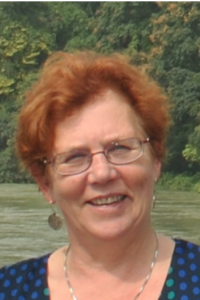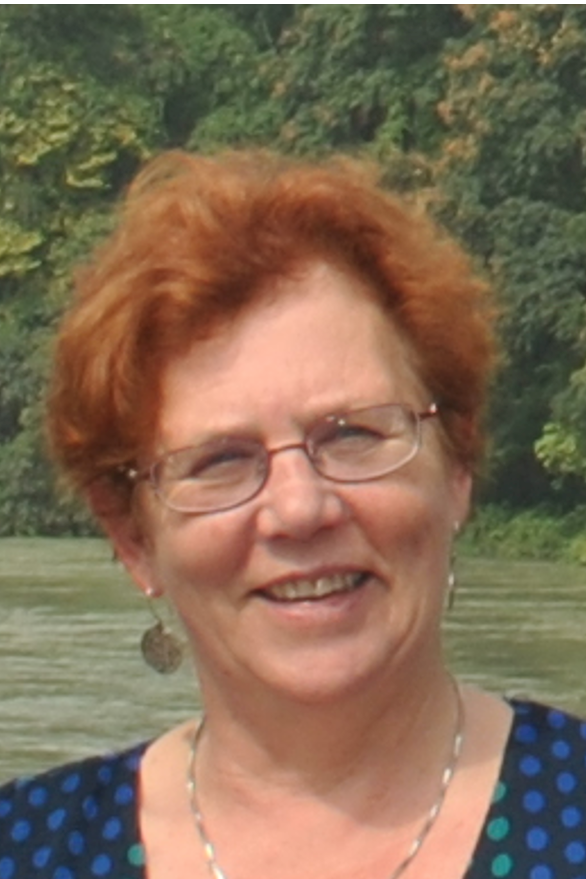“Be prepared for serendipitous events”
 Sandy is a Professor in Global Palaeoclimates and Biogeochemical Cycles at the University of Reading. She was awarded her BA (Hons) from Cambridge, her MSc from Macquarie University, Australia and her PhD from Lund University, Sweden.
Sandy is a Professor in Global Palaeoclimates and Biogeochemical Cycles at the University of Reading. She was awarded her BA (Hons) from Cambridge, her MSc from Macquarie University, Australia and her PhD from Lund University, Sweden.
Aside from being the co-lead PI for the LEMONTREE project, Sandy is also co-chair of the ‘Palaeoclimate Modelling Intercomparison Project’ (PMIP), and one of the Co-Directors of the Leverhulme Centre for Wildfires, Environment and Society.
Sandy’s research is focussed on the interaction between climate and the terrestrial biosphere, using land-surface- models to better understand the geologic past and predict future climate responses. Her focus now is on applying eco-optimality theory and trait analysis to improve vegetation models.
She is a world leader in the synthesis of palaeo-environmental data with an impressive publication record that has seen her be consistently reported as a ‘Highly cited author’ (Thompson Reuter).
First up in our new ’10 Questions with…’ series, Sandy took some time out of her busy schedule to answer our questions…
1. As lead PI for LEMONTREE, what is your goal for this project?
I think it’s to demonstrate that we can in fact model vegetation dynamics in a simple and robust way, using eco-evolutionary optimality approaches. The key reason for wanting to do that is to remove at least one source of frustration with the climate models that we have now, which perform very badly when challenged with large climate changes largely because of the poor representation of the terrestrial biosphere. We need to incorporate fire into the vegetation models in a robust way, because when fire is included in these models it is really poorly done. They do not currently consider the fact that plants are adapted to their environment and fire is part of their environment. I think that we can model fire with an optimality approach and this would be a first, nobody’s doing that yet.
What I’d really like to do is come up with an integrated vegetation model that can be implemented in a land surface model and in a climate model so that we can demonstrate that these new theoretical approaches are worth pursuing because there’s a lot of other things that can be done using eco- evolutionary optimality.
2. What is it about the project that sets it aside from other research projects looking at eco-evolutionary optimality theory?
I think that what sets us apart is the level of ambition, LEMONTREE is a really big project. It’s got some very diverse skill sets among its PI’s and the postdocs, and what we are trying to do is tackle things from the fundamentals and then develop the model from scratch. I think many other groups that are doing this kind of work, using EEO optimality, tend to focus on one aspect of the ecosystem, whereas what we are trying to do is pull the whole lot together. LEMONTREE is just a stepping- stone. We have some big ambitions with this work and who knows, there might be LEMONTREE part 2 after this.
3. Aside from LEMONTREE, you also have your SPECIAL group (Sandy’s Palaeo Environment and ClImate AnaLysis group). Tell me more about that.
Palaeo work is really the place that I started my research. I really got into vegetation modelling as a way to understand the palaeo data better. The key point here is that the recent past provides us only with the very limited window from which to view climate and environmental change and climate variability and environmental variability. If you’ve only got 50 years of observations, then you can’t look at things that show millennial trends or even cyclicity of 20 to 30 years. Past climate provides us with an opportunity to look at really big changes in the climate and understand what drives climate change – it’s a way of improving the tools we have to project 21st century climate changes.
The idea of the SPECIAL group was really trying to document past climate and environmental changes. We’ve had a lot of an emphasis on creating databases, for example, databases of climate, fire, vegetation, hydrology, speleothems. These databases then enable us to look at global patterns and try to understand mechanisms and feedbacks in the land surface and vegetation systems. But also, to help in understanding how climates have changed and what drives those changes.
4. Does your love of palaeo data stem from you wanting to understand what we’re in for in the future or have you always been interested in the geological past?
No, I think the point is that when I started this stuff, we weren’t worried about the future. Global warming wasn’t as big an issue. I think there were two things that got me interested. First of all, I had two really enthusiastic tutors at Cambridge, Jean and Dick (Alfred Thomas) Grove. They both did Palaeo work in one sense or another, and they just they were so enthusiastic about it. And they really imbued me with an idea that it was something worthwhile doing. It seemed glamourous; it was a bit like how kids like dinosaurs.
And then I suppose the other thing was that when I was coming through Cambridge, that was the very start of the era of developing climate models. It was a fever time, and I was just very lucky to get involved. I got to work with people who were working on climate models and using the models to start understanding past climate changes. It was only later when we started thinking about future climate, that I realized that if we want to test predictions from the models, we must test them against things that we know, and the palaeo data allows us to do that. Unfortunately, it’s still the case today models may predict the sign of past climate changes correctly, but the magnitudes are way off. Which I think is probably true for future climates too.
5. We have seen huge shifts in climate in the geological past, how concerned are you for climate change that we’re already starting to experience and projected to experience?
I think it’s unlikely that we’re going to stay at 2°C global warming. However, I think it’s a question of perspective, so it depends on what you’re worried about. If you’re worried about the planet, the biosphere, biodiversity, I’d say it’s not a problem because we’ve been through this before and Mother Nature has got it all handled.
What I am worried about is humans. There’s a lot in the literature about the impacts on biodiversity but I think this is just masking the hidden agenda, of how people will survive, and for that there is no guarantee. We need to put a lot more emphasis on adaptation to inevitable climate change. If you don’t care very much whether humans go extinct or not, you know then who cares? One way or another planet earth will go on, I’m just not sure if humans will be part of it.
6. Who has had the biggest influence on you?
I think there have been several influences in my life. Jean and Dick Grove at Cambridge who I have already mentioned. Also, Lucy Adrian who was my personal tutor at Newnham College. She taught me that there is no such thing as can’t, in no uncertain terms.
When I was doing my Masters in Australia, I worked with Ron Paton who was a soil scientist. He really taught me to look at things, not be content with reading a paper with some theoretical understanding, but to go out in the field and actually look at what was happening.
And then, as I said, I came in at the beginning of when the climate modelling took off and John Kutzbach who was at Madison at that time and was very influential in the sense that he taught me about climate models in particular and that they were hypothesis testing tools. I think that is something really important for people to know because today these models are seen as telling us what climate is going to do and how it is going to change vegetation and people have perhaps forgotten that they are just a tool. The best way of using a model is to test a hypothesis. The projections are just hypotheses.
7. What do you think has been your key to success?
I think being in the right place at the right time is key. I’ve been lucky to come into projects just at the right time. I can remember when I got involved in looking at climate models, I was at a meeting where John Kutzbach said he really want somebody to look at something for him and I said enthusiastically, ‘I’ll do it’. I had the information and I just wanted to be there and part of it. If you’re passionate about something, then you really stick with it, it means that you become successful.
8. You’ve lived in many countries, how many languages do you speak or understand?
Ah, well, that’s a good question. So, I can speak French, English and probably Double Dutch most of the time! I used to speak German and Swedish, at least to a kind of living standard. But those are sort of so irrevocably mixed now and I am a bit rusty.
Funnily enough, I do read more European languages than I can speak, and that’s down to Jean Groves. I worked for her during my undergraduate study when she was rewriting her book ‘The Little Ice Age’ and she gave me a whole bunch of papers that I was meant to précis. The first ones were fine; English, French and German. Then there were a whole bunch in Norwegian and Swedish, Serbian, Croatian, whatever. And when I went back and said these are all in languages unknown to me, she reminded me that there were things called dictionaries and grammar books that could help. I found the more technical the paper, the better, as the science words were all very similar!
9. Home is now a village in Devon. What is it you like most about living there?
The peace and quiet. The countryside. We have good neighbours, and the weather down here always seems to be better than in Reading! Of course, most of our neighbours are farmers, and so, we have a blow-by-blow discussion every week about the quality of the rain and what it’s doing to the grass and cows. It’s like a new perspective on the weather. You can see why people talk about it so much here. I now know the difference between a ‘minor’ and ‘major’ and a ‘productive’ shower. It’s typical of Brits to talk about the weather, but down here it’s a terrible important thing to think about!
10. And so lastly, what advice would you give to someone who’s at the start of their career?
Be passionate. It’s not a job, it’s a full-time occupation. There are going be setbacks and sometimes you just need to be obstinate because the world doesn’t accept that your brilliant idea is really a brilliant idea, even though it might be. Be prepared for serendipitous events. You have to be prepared and look out for chances, and when an opportunity arises, don’t hesitate. My career was totally unplanned. But when an opportunity came up and I thought ‘hey, that sounds great’, I was ready for it. And that’s I think the way these things often happen.

